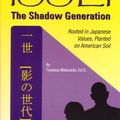What do you hate most about this world? Posed this question, you are undoubtedly thinking of forces that have most deeply disrupted and disturbed your life and that of those around you. Disease, poverty, violence, all sure quickly bubble up from the depths of your memories and highlight the pages of the story that is your life when you think about the answer to this question. Needless to say, such an answer will vary with every individual, and even within every individual, such an answer will vary with the time and situation we find ourselves in. If I had to answer this question today, I would have to say that the two things I hate the most are saying goodbye and being invisible, and surely, most people will have experienced these two things at some point in their lives. But for Latin American Nikkei in the U.S. these two factors define much of our history as well as our political and cultural struggle. I’d like to steal some of your time to explain what I mean…
Emigrants have to say goodbye, and it is the saddest thing in the world, especially if you are not sure when or if you’ll see those that you are leaving again. During the Meiji restoration, this experience was a reality all too common to Japanese emigrants. Beginning in the late 1800’s, these emigrants left Japan for many different places, most notably were the Americas. For many, the first choice of destination was the United States, but partly as a result of racist exclusionary policies of this country, many Japanese emigrants found themselves in Latin America forming new lives. My grandfather was one of them. His father and him left Okinawa when he was 15. Like many, the original goal was to come back to Japan, but that fate was never realized. Instead, my Ollii (was what his grandkids called him), never saw his mother again, and only got to know his siblings when they were all in the later stages of their lives. Ollii never talked about it much, as he was never one to complain of the deal he had been dealt. Still, I can only imagine the heartbreaking disillusion he must have felt when it was clear he would not return to Japan. To have one’s family broken apart due to poverty must have been very difficult for him to deal with; this can only leave me with an image of my Ollii being an incredible person. While a child in Peru, I never thought that I’d have to go through the same thing almost an entire century after he did.
Life in Peru was not easy. Many Japanese immigrants found themselves bound to exploitative labor contracts that severely limited their ability to pursue their goals in Peru. However, through much hard labor, ethnic solidarity, and good luck, the Japanese in Peru began to succeed. In a rather short period of time many Japanese-owned small businesses sprung up. But this happened so quickly that they came to be seen as unfair economic competition. The result of this was much racial prejudice and ethnic antagonism towards the new migrants. This explosive situation was exacerbated by the animosity directed towards Japanese migrants in response to the ongoing Japanese military campaigns on the other side of the globe. In 1940, a Peruvian woman was accidentally killed during a conflict between two Japanese nationals that turned violent in a Japanese home. The news of this event was the catalyst for a riot that saw about 600 Japanese homes and businesses looted in the days following the event.
This would not be the last, nor worst experience of racism the Japanese in Peru would have to endure. After the bombing of Pearl Harbor in December 7, 1941, the Japanese in Latin America would face an epoch of persecution and incarceration parallel to that of the Japanese Americans in the U.S. Pacific Coast. The political influence of the U.S. in the South American hemisphere was so strong that it was able to coordinate the kidnapping of Japanese Latin Americans. Some 2200 Japanese Latin Americans were eventually placed in U.S. concentration camps in the following years that the war lasted. Of these, about 1800 were taken from Peru. In addition to its own camps, through U.S. political influence, camps in Panama and Cuba were also functioning. The process by which Japanese Latin Americans were selected to be interned mirrored that of the process by which the first Japanese American internees (immediately following the bombing of Pearl Harbor) in the U.S. were selected. Many were singled out due to their leadership positions in Japanese migrant communities. Business owners, professionals, and community leaders were all perfect targets for these kidnappings. The lack of concrete evidence to jail these individuals, as well as the anti-Japanese migrant propaganda that fueled this unfounded prejudice and hatred also mirrored what was occurring in the U.S. In the U.S. we see ridiculous rumors of Japanese farms being used as guiding signs for the Japanese air force. In Peru, fashion trends of Nikkei were taken to be “uniforms” symbolizing loyalty to Japan (Higashide p. 127). Fifth column hysteria is an easy way to criminalize immigrants in the name of national security; this proved true in both the U.S. and Peru.
Ollii’s economic efforts in Peru were fortunately, relatively fruitless. Let me explain. Because those that were targeted were of higher standing in the Japanese migrant community, my Ollii escaped the fate of being kidnapped. Others weren’t so lucky. Others had to say goodbye yet again. Seiichi Higashide narrates the moment of his arrest:
“I could see my wife holding back her tears. She was in her last month of pregnancy with our fifth child. She brought the children over and stood by me silently. The four children sniffled, but they set their lips firmly to keep from weeping. When I said, ‘I’ll be back soon,’ no one answered.
The taxi began to move. Suddenly, a young Nisei employee, Victor Narita, rushed up to the taxi and grasped my hand through the open window while running beside the moving taxi. His face was contorted with emotion, and he began to cry unabashedly. The tears I had been holding back finally came streaming from my eyes. The taxi picked up speed and the figures of those standing in front of our shop grew smaller and smaller. They kept waving and called back over and over, ‘Adios, sayonara…’ I leaned out of the window until I could no longer see them.” (Higashide, p. 137)
As sad as this passage may be, one cannot really grasp how excruciating this experience is without taking into consideration that this was the second time that Mr. Higashide had to say goodbye to the family he belonged to and to the country he called home. And this time, he had no choice. He was just pawn in a triangle of hate as Gardiner (1981) puts it.
In the 1990’s my grandfather had to go through the same thing. We left Peru, knowing that we wouldn’t return, not to live there anyways. I remember the early 90’s as a period of time distinctly marked by goodbyes. It seemed to me we were always at Lima’s international airport saying goodbye to friends and family leaving both to Japan and the U.S. My Ollii was born in Japan, lived in Peru and died in the U.S. Can a life be more interrupted than this? My Ollii’s and Mr. Higashide’s experience were different in that my Ollii came to the U.S. voluntarily (as voluntary as escaping economic hardships is), but they were similar in that they both had to say goodbye twice, they both had to start from NOTHING twice, they both had to learn to adapt, assimilate, acculturate, or whatever politically correct term can be used to describe this, twice. They were twice migrants, and what’s worse, now they were a twice minority: a minority within a minority. How much more politically vulnerable can you get?
Both my Ollii and Seiichi Higashide have passed away; they are part of our memories now, and what do we have left? The one thing we’ll always have left is work to do.
The work we have left to do has everything to do with the history I’m narrating, and at its core is the honoring of the legacy left by my Ollii, Mr. Higashide, and all those other Japanese Latin Americans, dead and alive in the U.S. As minorities within a minority, we’re relegated to a position of political and cultural invisibility. The small numbers that constitute Japanese Latin Americans in the U.S. have made us vulnerable, but not disempowered; invisible, but not prideless; poor in numbers, but not in culture. The work we have left to do is then both political and cultural.
The struggle of Japanese Latin Americans in the U.S. is a struggle against invisibility, both in the political as well as the cultural arena. Most people in the U.S. are completely unaware of our existence in this country (or in the world for that matter). We are caught in a racial order ruled by the one-drop rule. The one-drop rule, created to oppress slaves of mixed race and maintain the white supremacist racial order consequently categorized people into discrete subgroups, thereby neglecting the complexity of racial/ethnic identity. So Japanese Latin Americans in today’s society are often boxed into one group or the other. The idea of Japanese people speaking Spanish or Portuguese is foreign and inconceivable to the average American. You’re either Japanese or Latin American, but both?! The result of this is that our identities, the problems we face, and our accomplishments are easily taken to be that of the other groups we belong in, the Asian community or the Latino community.
The most proving example of this is the battle for redress that is ongoing for Japanese Latin Americans. For folks like the late Seiichi Higashide, redress was never fully accomplished. When the Civil Liberties Act of 1988 provided an apology and $20,000 in compensation for Japanese Americans still alive who had endured the horrors of incarceration, Japanese Latin Americans were left out. The Japanese Latin American status was at first labeled by the U.S. government to be that of “illegal aliens;” Japanese Latin Americans in the U.S. found this ridiculous since they had been brought to the U.S. and put into prisons without a choice or even a trial. Based on their “status,” they were deemed ineligible to reap the benefits and justice provided by the Civil Liberties Act of 1988. In an attempt to right this wrong, the Mochizuki v. U.S. (1996) case, was settled in that an apology was granted to Japanese Latin Americans and a $5,000 compensation was provided for the termination of the case. While in support of those who accepted the compensation, many continued the struggle for EQUAL justice. The experience of Japanese Latin American internees had been worse in many ways than that of Japanese Americans, and to be offered less was not acceptable. This issue yet remains for the most part invisible to the general public. The issue of redress was defined as a Japanese American issue. Thus, when the issue was resolved for Japanese Americans, it is erroneously assumed that the issue was solved in its entirety. Japanese Latin American issues were equated to be those of the Japanese American community, and therefore deemed resolved. In turn, we think of redress being remembered. This issue needs to be more than remembered; it needs to be revisited.
In the need to continue this fight, Campaign for Justice was founded in 1996 with the objective of obtaining full redress for JLAs. Today, Campaign for Justice is fighting to have a hearing on H.R. 662, the Commission on Wartime Relocation and Internment of Latin Americans of Japanese Descent Act before the end of the 110th Congress. The bill would establish a commission to investigate and recommend appropriate remedies on the World War II abduction and internment of over 2,200 persons of Japanese ancestry from 13 Latin American countries by U.S. government. The fight for justice, thus, continues. Like I said… vulnerable, but not disempowered; invisible but not prideless; poor in numbers but not culture.
For more information, visit http://www.campaignforjusticejla.org/index.html
Or e-mail us at info(at)campaignforjustice.com.
Bibliography
Gardiner, Harvey. 1981. Pawns in a Triangle of Hate: The Peruvian Japanese in the United States. University of Washington, Press. Seattle, WA.
Higashide, Seiichi. 2000. The Memoirs of a Japanese-Peruvian Internee in U.S. Concentration Camps. University of Washington Press. Seattle, WA.
*Learn more about this issue at "Redress Remembered: WWII Rendition of Japanese Latin Americans," a public program this Saturday, October 25, 2008 at the Japanese American National Museum in Los Angeles, CA.
© 2008 Shigueru Julio Tsuha





